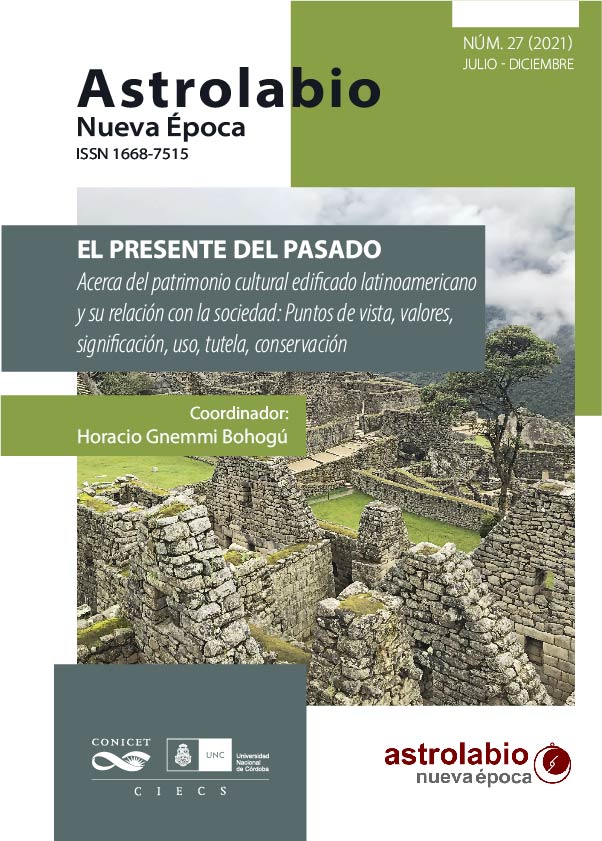Crime, sexuality and conurbano in José Celestino Campusano’s
Main Article Content
Abstract
This article examines the figures of crime and sexuality within Argentine cinema with the interest of reflecting on the way they construct images on certain bodies in narrative processes that expose the subjects represented in contiguity with ideas of the cultural order. These are symbolic procedures that, by linking concrete bodies with practices and behaviors through the audiovisual register, establish social reproduction parameters. The position of the camera does not answer the question of the relevance of adopting the perspective of the victim or the perpetrator, but involves reflecting on the way in which appearance of a precise face and body in multiplication and contiguity (with aspects that imaginatively connect class, ethnicity, and gender) is linked to a referentiality that repeats or reverse a process of social affirmation. With a methodology that takes up the practices of cinematographic analysis, the tools of art historiography, and the proposals of political philosophy as a background for certain theoretical concerns, these problems are developed from a journey through the notions about genre cinema, some contemporary films that portray the conurbano, and particularly the cinema of José Celestino Campusano.
Downloads
Article Details

This work is licensed under a Creative Commons Attribution-NonCommercial-ShareAlike 4.0 International License.
Astrolabio, Nueva Época está protegida bajo licencia Licencia Creative Commons Atribución-NoComercial-CompartirIgual 4.0 Internacional. La propiedad intelectual de los artículos pertenece a los autores y los derechos de edición y publicación a la revista. Los artículos publicados podrán ser usados libremente para propósitos científicos y académicos, siempre y cuando se realice una correcta citación de los mismos. Cualquier persona física o jurídica que desee reimprimir parte o la totalidad de algún artículo, deberá obtener permiso escrito de los editores de Astrolabio Nueva Época, quien lo otorgará con el consentimiento del autor.
References
ALTMAN, Robert. (2000). Los géneros cinematográficos. Barcelona: Paidós.
BAZIN, André. (1990). ¿Qué es el cine? Madrid: Rialph. (Edición original, 1958.)
BENSHOFF, Harry. (1997). Monsters in the Closet. Homosexuality and the Horror Film. New York: Manchester University Press.
BUTLER, Judith. (2002). Cuerpos que importan. Sobre los límites materiales y discursivos del “sexo”. Buenos Aires: Paidós.
CARMAN, María. (2010). “¿La clase social entre paréntesis? El caso de la Aldea Gay en Buenos Aires”. Katálysis, 13-1, 49-58.
CASTELLO, Guilio Cesare. (1962). El cine neorrealista italiano. Buenos Aires: Eudeba.
COHAN, Steven y HARK, Ina Rae (eds.). (1993). Screening the Male. Exploring Masculinities in Hollywood Cinema. London: Routledge.
CONTRERAS, Sandra. (2018). Relato y comunidad. Sobre el primer cine de José Celestino Campusano. En En torno al realismo y otros ensayos, pp. 112-125. Rosario: Nube Negra.
DELEUZE, Gilles. (1995). Optimismo, pesimismo y viaje (carta a Serge Daney). En Conversaciones 1972-1990, pp. 113-130. Valencia: Pre-textos.
DE OLMOS, María Candelaria. (2019). Lo bueno, lo malo, lo verdadero. Una lectura de Vikingo (2009) y Fantasmas de la ruta (2014) de José Celestino Campusano. En Santiago Ruiz y Ximena Triquell (comps.), Construcción de audiovisuales de la conflictividad social en Argentina, pp. 114-129. Córdoba: Facultad de Artes de la UNC.
DIDI-HUBERMAN, Georges. (2014). Pueblos expuestos, pueblos figurantes. Buenos Aires: Manantial.
FERRO, Gabo. (2010). Degenerados, anormales y delincuentes. Gestos entre ciencia, políticas y representaciones en el caso argentino. Buenos Aires: Marea.
GUBER, Rosana. (2011). La etnografía. Método, campo y reflexividad. Buenos Aires: Siglo XXI.
INCARDONA, Juan Diego. (2008). Villa Celina. Buenos Aires: Interzona.
KRATJE, Julia. (2015). “Dandismo intempestivo. La cadencia del trabajo doméstico en Réimon (Rodrigo Moreno, 2014)”. Imagofagia. Revista de la Asociación de Estudios de Cine y Audiovisual, 11, 1-7.
LARKE-WALSH, George. (2010). Screening the Mafia: Masculinity, Ethnicity and Mobsters from The Godfather to The Sopranos. Jefferson, NC: McFarland.
LEMA-HINCAPIÉ, Andrés (2015). A Gaynster Quasi-Tragedy: Eroticism and Secrets in Plata quemada (Marcelo Piñeyro, 2000). En Andrés Lema-Hincapié y Debra Castillo (eds.), Despite all Adversities. Spanish-American Queer Cinema, pp. 53-70. New York: Suny.
MORENO, María. (2015). Black out. Buenos Aires: Literatura Random House.
MORGEN, Paula. (2014). Representación de la pobreza: señales de cambio. En Diana Paladino (comp.), Documental/ficción. Reflexiones sobre el cine argentino contemporáneo, pp. 69-84. Buenos Aires: Eduntref.
NEALE, Steve. (2000). Genre and Hollywood. London: Routledge.
OYOLA, Leonardo. (2011). Kriptonita. Buenos Aires: Literatura Random House.
PRIVIDERA, Nicolás. (2014). El país del cine. Para una historia política del nuevo cine argentino. Córdoba: Los Ríos.
RANCIÈRE, Jacques. (2013). El espectador emancipado. Buenos Aires: Manantial.
RICH, Ruby. (2013). New Queer Cinema. The Director’s Cut. London: Duke University Press.
RUIZ, Alejandra. (2017). La impronta de Pasolini en el Cine Bruto de José Campusano. En Héctor Kohen y Sebastián Russo (comps.), Los condenados. Pasolini en América Latina, pp. 155-168. Buenos Aires: Nulú Bonsai.
SALESSI, Jorge. (1995). Médicos, maleantes y maricas, Higiene, criminología y homosexualidad en la construcción de la nación argentina (Buenos Aires: 1871-1914). Rosario: Beatriz Viterbo.
SHOHAT, Ella y STAM, Robert. (2002). Multiculturalismo, cine y medios de comunicación: Critica del pensamiento eurocéntrico. Barcelona: Paidós.
VISCONTI, Marcela. (2017). Cine y dinero. Imaginarios ficcionales y sociales de la Argentina (1978-2000). Buenos Aires: Fundación Ciccus.
WALKER, Alice. (1989). Prisioners of Image: Ethnic and Gender Stereotypes. New York: Alternative Museum.
WARSHOW, Robert. (1975). The ganster as a Tragic Hero. En The Inmmmediate Experience: Movies, Comics, Theatre and other Aspects of Popular Culture, pp. 127-133. New York: Atheneum.

